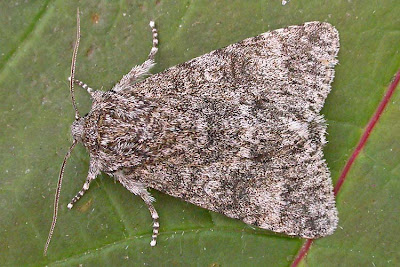It isn't only moth that I get in my moth trap. Here's one bug and three attractive moths from last night.
The Cockchafer or Dorr Beetle is also known as the May Bug. They are on the wing from May to July and are normally encountered on warm evenings.
 Despite to complex balancing system that flying insects have the May Bug is an erratic flier, often crashing into people or objects as it noisily flies about. The adult beetle (Melolontha melolontha) often swarm around trees and are quite destructive as they each the leaves.
Despite to complex balancing system that flying insects have the May Bug is an erratic flier, often crashing into people or objects as it noisily flies about. The adult beetle (Melolontha melolontha) often swarm around trees and are quite destructive as they each the leaves. At around 3 cm and quite heavily built they can give yo a stinging blow if they fly straight into you. Cockchafers have a 3 year life cycle. After mating the female digs about 20 cms into the soil to lay her 10 to 20 eggs. The eggs hatch after 21 days and the larvae remain in the soil for a further two years feeding on roots. They are sometimes know as Rook worms as they are one of the favourite foods of Rooks.
At around 3 cm and quite heavily built they can give yo a stinging blow if they fly straight into you. Cockchafers have a 3 year life cycle. After mating the female digs about 20 cms into the soil to lay her 10 to 20 eggs. The eggs hatch after 21 days and the larvae remain in the soil for a further two years feeding on roots. They are sometimes know as Rook worms as they are one of the favourite foods of Rooks. The wing cases and the pronotum are covered in tiny grey hairs, giving the cockchafer a dusty appearance.
The wing cases and the pronotum are covered in tiny grey hairs, giving the cockchafer a dusty appearance.One of the gems of English moths in the Small Elephant Hawk-moth, It is tiny for a Hawk-moth but is still exquisitely marked. It is more locally distributed than its relative, the Elephant Hawk-moth, it prefers chalky districts and dry grassy localities, but is found in a range of habitats.
 Adults hover while feeding at flowers from dusk onwards. They are attracted to light and can appear in reasonable numbers in favoured localities. The larvae can be found from July until September on bedstraw Galium spp. It overwinters as a pupa.
Adults hover while feeding at flowers from dusk onwards. They are attracted to light and can appear in reasonable numbers in favoured localities. The larvae can be found from July until September on bedstraw Galium spp. It overwinters as a pupa.The Tawny Shears is another moth that favours dry grassy or stony habitats such as chalk downland or shingle beaches and we've got lots of both round here! The caterpillars feed on the seeds of various Campion species.




1 comment:
Some nice moths there, Tony.
Small Elephants are a smart species.
Post a Comment